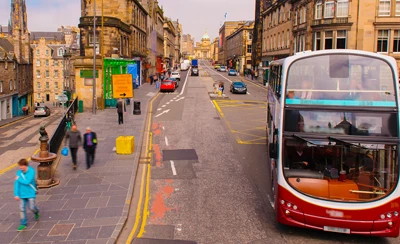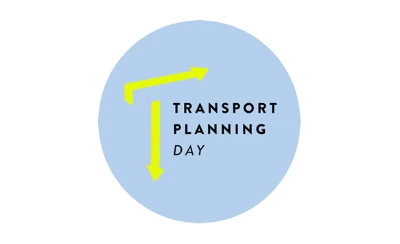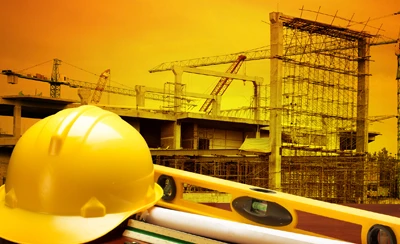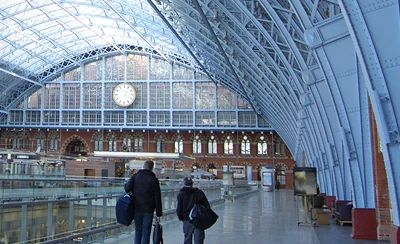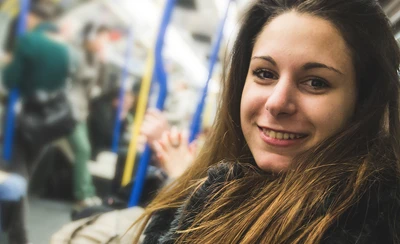Will our experience of reducing our travel during the Covid-19 crisis have a lasting impact on our travel behaviour? Dr Susan Kenyon from Canterbury Christ Church University considers the evidence, before suggesting how transport planners could act now, to support lasting change.
It is important, in a time of crisis, to seek out the positives: to see possibility; to focus not on what we have lost, but on what we might gain.
For some, the possibility that we might see a permanent reduction in the amount that we travel is one such positive.
However, everything that we know about travel behaviour – why people travel as they do and what causes travel behaviour to change – suggests that this is unlikely, unless we act now, to lock-in lockdown travel behaviours.
In this blog, I explain why I believe that we will see a swift bounce back to normal travel behaviour once the lockdown is lifted. Following a brief period of greater-than-normal travel as we make up for lost time, within months, the activity patterns that cause us to travel will settle back into a built environment that hasn’t changed. Travel will once again become a social and cultural norm; habits will return; our biological and psychological impetus for movement will be realised.
This said, there is the possibility that, with purposeful, targeted intervention by government, transport authorities and transport planners, some reduction in travel could be maintained. The lockdown has disrupted behaviour; it hasn’t changed it. I suggest some steps that could be taken, post-lockdown, which could encourage a change to more sustainable travel behaviour, in the longer term.
Covid-19 has led to a rapid decline in travel
The lockdown that we are experiencing in the UK as a result of the fight against Covid-19 led, initally, to a rapid decline in travel. Statistics showing this decline in mobility take centre stage in daily UK government briefings. Most of us are travelling less. Following the closure of workplaces, schools and universities, many of us, including myself and colleagues in the Politics team at CCCU, are working and learning from home. We are shopping locally, or receiving deliveries; and we have cancelled travel for business, leisure, social activities and tourism.
This has offered a glimpse of a possible alternative world, long hypothesised, where physical travel to access work, learning, shops, services, social networks and other goods is no longer as necessary. Working, learning, shopping, socialising from home seemed unreasonable a month ago, but today seems prudent, workable – even attractive.
There has been much excitement in the press that this change will last beyond the immediate crisis. Many commentators have suggested that, because a reduction in travel has been proven to be possible, it is logical to expect that we will continue to shun travel, post-lockdown. More than this, a reduction in travel has proved to be positive: air pollution has decreased, we gain time by not travelling, which we can invest in work, other activities, our families. When the lockdown ends, commentators suggest, individuals will rationally assess the proven and positive benefits of reducing their travel and choose to maintain their lockdown-induced reduction, as far as possible, in the post-lockdown world.
Unfortunately, this is rarely how decisions, particularly travel decisions, are made. My research suggests that our travel behaviour is informed by four key types of behavioural influences. Much of the time, we are not able to control these influences and, because of this, we aren’t able to choose our travel behaviour, or to choose to change it. Even when we are able to choose to change our behaviour, much of the time, we aren’t willing to do so. In the following discussion, we will see that it is unlikely that this will change, post-lockdown, unless transport planners take swift action to disrupt travel patterns, to make us more able and more willing to change.
How travel decisions are made: are we able to change?
The first key influence on our travel behaviour is our Activities and Lifestyle. By and large, we travel because we need to access activities. Whilst the technology to facilitate virtual access to activities has been available for a long time, we hadn’t seen large-scale substitution of travel in preference of virtual access until now. In fact, government statistics and academic studies show that, on average, we have continued to travel for the roughly same amount of time, the same number of trips and longer distances, despite the possibility of virtual mobility.
Why is this? It is possible that this is because we hadn’t recognised the benefits before now, or that the possibility of virtual mobility wasn’t part of our collective consciousness. Perhaps we hadn’t learnt how to use the tools, or the technology was not sufficiently advanced, to provide a good experience. Perhaps we needed to be shaken out of the habit of travelling, or to experience the positives.
If this is the case, the radical decline in travel that we have seen during lockdown could be maintained. However, a more plausible explanation is that having the opportunity to reduce our travel isn’t the same as being able to change; and that, as well as being able to change our travel behaviour, we must also be willing to do so.
Thinking firstly about being able to conduct our activities online. In lockdown, whilst reliable statistics are not yet available, anecdotal evidence is telling us that, as was the case before the lockdown, not everyone is able to access virtual mobility. Thinking about the activities that are most commonly mentioned as being possible without travel, people who are excluded from these activities online tend to be the same people who experience transport-related social exclusion from these activities. For example, 40 per cent of workers in the UK think they could be able to work from home, compared to 54 per cent who could not, with 9 million estimated to be furloughed, in large part because they cannot work from home. Those who are able likely to be younger, male professionals, living and working in London and the South East. Ability to shop online is similarly privileged. Not all school children and only two thirds of University students are able to learn online. Anecdotal evidence from our own students has highlighted lack of computers, broadband, a quiet space and time, due to caring responsibilities or paid work, as key barriers to learning from home. And whilst social media companies report rapid uptake of online social networking, not all of us are able to access this activity.
This leads us naturally to the second key influence on our travel behaviour: Infrastructure and the Built Environment. We may have become more willing, as a result of our lockdown experiences, to become more virtually mobile, but not necessarily able because, in the UK, we don’t currently have the infrastructure (encompassing broadband, quality computing, appropriate space, skills, software) to enable a move to virtual mobility, for all people, or activities. The possibility and positivity of virtual mobility during lockdown has been proven for some people and some activities, but if we conflate this to all, we risk mirroring mobility-related exclusion and masking virtual-mobility-related exclusion.
We live in a built environment in which physical mobility is both necessary and expected to participate in activities. Economic, planning, social and transport policies have resulted in living environments and activities that are dispersed across large, ever-increasing distances. When we emerge from the lockdown, this will not have changed – indeed, there is a risk that dispersal will increase, if a reduction in physical mobility leads to greater sprawl.
How travel decisions are made: are we willing to change?
Our ability to maintain reduced mobility is not the only barrier to permanent travel behaviour change, post-lockdown. Our willingness to change is likely to be an even greater influence.
Our third group of behavioural influences, Biology and Psychology, influences our willingness to change. From academic research conducted prior to the lockdown, we know that willingness to change travel behaviour, to reduce, remode, reroute, retime, or shift to virtual activities, was low. Behavioural science has helped us to understand why.
Travel behaviour (and change in the same) is, to borrow a phrase, ‘predictably irrational’. Much of the time we don’t choose to behave as we do: it just happens automatically, quickly and unconsciously, based on habits, biases, intuition, fear, emotion. We rarely compare the costs and benefits of different actions before deciding, on balance, how to behave. This is part of our psychology, but our biology may also important in determining our travel behaviour: studies suggest that humans have an innate biological need for physical movement for well-being.
Thus, it is unlikely that individuals will rationally assess the benefits of reducing their travel during lockdown: this simply isn’t how most of us make decisions. We have seen this in the swift return to normal travel following both national/international crises (the fuel protests in the early 2000s; the 9/11 terror attacks; the economic crisis in 2008/9) and other temporary adjustments to individuals or regions’ travel behaviours (moving house, temporary receipt of a free bus pass, London 2012 Olympic Games).
The fourth and final key type of behavioural influences considers the role of Society and Culture in our willingness to change. We are all influenced to behave in certain ways by social or cultural norms: the common set of ideas, values and beliefs that tell us how to behave if we are to fit in. Few of us are willing to consciously challenge these, to behave differently to those around us. Part of being human is that we cannot help but copy the behaviour of others, because we have evolved to show commitment to others by reciprocating their behaviours. We are also heavily influenced by how others make us feel about ourselves and our actions. In the UK, our society and culture enforce expectations of mobility and, more specifically, automobility. This is reinforced by art, literature, music and film, as well as by policy and planning. And it isn’t just mobility cultures – thinking of education and employment cultures, where presenteeism is valued as an indication of performance.
We have seen what can be achieved during an existential crisis. But the temptation to fight the virus and bounce-back to normal will be strong, because of the importance of physical mobility in our social and cultural norms.
Transport planning actions to lock-in lockdown travel behaviours
Given these influences on our ability and willingness to maintain reduced travel, what can transport planners do to facilitate reduced travel, post-lockdown?
- Transport planners must be encouraged to move from being facilitators of travel to disruptors, challenging the assumption of mobility and adding virtual mobility into the conversation.
- Could disruption be through development planning? Perhaps new employment developments could require 20% working from home each day; perhaps new housing developments could include a telecottage?
- Could disruption be in the form of policy appraisal? All areas of policy – education, employment, health and social care, housing and neighbourhood renewal, poverty reduction, as well as planning and transport – are currently based upon an assumption of mobility. Going forward, applying a mobility appraisal to policy could help to disrupt this mobility-centred approach to government.
- Could transport planners work more with social scientists, to include behavioural and sociological aspects of travel in their day to day work ?
- Immediate actions to reduce travel in lockdown need to focus not on authority, but on marketing that makes reduced travel a social norm, a commitment, reciprocal behaviour that we like to do.
- In the longer term, once the immediate crisis is over, we can encourage people to gradually evolve their behaviour. This will help to make it easier to maintain the change, making it attractive and part of a wider social norm.
- Immediate actions to tackle our ability to reduce travel must focus on enabling virtual access. The digital divide is preventing access to work, learning, social networks, shopping. It is essential to audit and meet need for virtual mobility. In the longer term, to encourage continued virtual access, transport planners could include technology for virtual mobility in their transport appraisals.
- There is a real opportunity to reduce social exclusion through virtual access to activities. Embracing this by introducing the necessary infrastructure should be a priority.
- Finally, throughout the crisis, coverage of public transport has been negative, with a focus on the potential of travel by public transport to spread the virus. The government has stated that we have a ‘civic duty’not to use public transport. We must counteract the perception that public transport, rather than Covid-19, is the enemy, to ensure that public transport use does not fall, in favour of the car, once the crisis is over.
To conclude, there is an opportunity to reshape how we travel, once the immediate crisis is over. However, change will not arrive unprompted. Transport planners will need to act, to encourage travel behaviour change to embed and evolve, from necessity, to positive choice.
Dr Susan Kenyon is a Faculty Director of Learning and Teaching and Principal Lecturer in Transport, Politics and Society. She has studied transport and travel behaviour since 1998. Her module Transport, Politics and Society is open to second year students studying Politics and International Relations at Canterbury Christ Church University.

